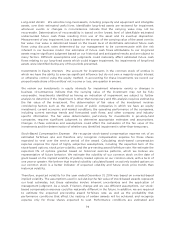Yahoo 2014 Annual Report Download - page 85
Download and view the complete annual report
Please find page 85 of the 2014 Yahoo annual report below. You can navigate through the pages in the report by either clicking on the pages listed below, or by using the keyword search tool below to find specific information within the annual report.
Foreign Currency Exposure
The objective of our foreign exchange risk management program is to identify material foreign
currency exposures and identify methods to manage these exposures to minimize the potential
effects of currency fluctuations on our reported consolidated cash flows and results of operations. All
counterparties to our derivative contracts are major financial institutions. See Note 9 — “ Foreign
Currency Derivative Financial Instruments” in the Notes to our consolidated financial statements for
additional information on our hedging programs.
We transact business in various foreign currencies and have international revenue, as well as costs
denominated in foreign currencies. This exposes us to the risk of fluctuations in foreign currency
exchange rates.
We had net realized and unrealized foreign currency transaction losses of $15 million, $6 million, and
$1 million for the years ended December 31, 2014, 2013 and 2012, respectively, which include the
impact of balance sheet hedging and remeasurements of foreign denominated assets and liabilities
on the balance sheets of the Company and our subsidiaries.
Translation Exposure. We are also exposed to foreign exchange rate fluctuations as we convert the
financial statements of our foreign subsidiaries and our investments in equity interests into U.S.
dollars in consolidation. If there is a change in foreign currency exchange rates, the conversion of the
foreign subsidiaries’ financial statements into U.S. dollars results in a gain or loss which is recorded as
a component of accumulated other comprehensive income which is part of stockholders’ equity.
A Value-at-Risk (“VaR”) sensitivity analysis was performed on all of our foreign currency derivative
positions to assess the potential impact of fluctuations in exchange rates. The VaR model uses a
Monte Carlo simulation to generate thousands of random price paths assuming normal market
conditions. The VaR is the maximum expected one day loss in fair value, for a given statistical
confidence level, to our foreign currency derivative positions due to adverse movements in rates. The
VaR model is used as a risk management tool and is not intended to represent either actual or
forecasted losses. Based on the results of the model using a 99 percent confidence interval, we
estimate the maximum one-day loss in the net investment hedge portfolio was $22 million and $12
million at December 31, 2014 and 2013, respectively. The maximum one-day loss in the cash flow
hedge portfolio was $3 million and less than $1 million at December 31, 2014 and 2013, respectively.
The maximum one-day loss in the balance sheet hedge portfolio was $2 million at December 31, 2014
compared to a $2 million and $3 million loss at December 31, 2013 and 2012, respectively. Actual
future gains and losses associated with our derivative positions may differ materially from the
sensitivity analysis performed as of December 31, 2014 due to the inherent limitations associated with
predicting the timing and amount of changes in foreign currency exchange rates and our actual
exposures and positions. In addition, the VaR sensitivity analysis may not reflect the complex market
reactions that may arise from the market shifts modeled within this VaR sensitivity analysis.
Revenue ex-TAC and related expenses generated from our international subsidiaries are generally
denominated in the currencies of the local countries. Primary currencies include Australian dollars,
British pounds, Euros, Japanese yen, and Taiwan dollars. The statements of income of our
international operations are translated into U.S. dollars at exchange rates indicative of market rates
during each applicable period. To the extent the U.S. dollar strengthens against foreign currencies,
the translation of these foreign currency-denominated transactions results in reduced consolidated
revenue and operating expenses. Conversely, our consolidated revenue and operating expenses will
increase if the U.S. dollar weakens against foreign currencies. Using the foreign currency exchange
rates from the year ended December 31, 2013, revenue ex-TAC for the Americas segment for the year
ended December 31, 2014 would have been higher than we reported by $10 million; revenue ex-TAC
81
























